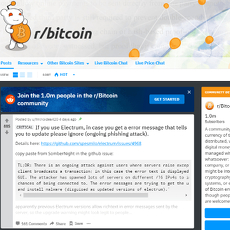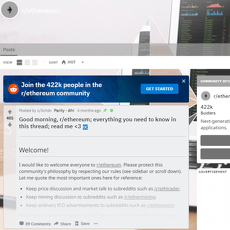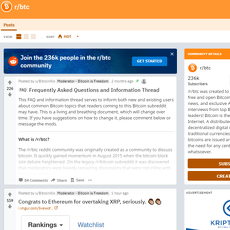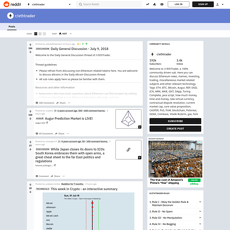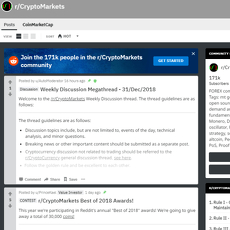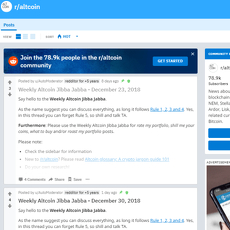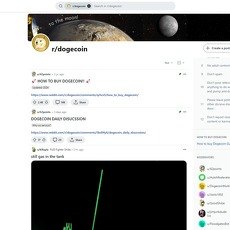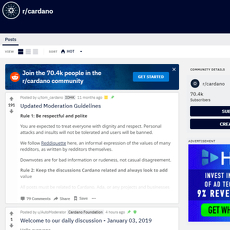r/CryptoMoonShots Review
r/CryptoMoonShots
www.reddit.com
r/CryptoMoonShots Review Guide: How I Use the Subreddit, Avoid Rugs, and Find Real Signals
Have you ever scrolled r/CryptoMoonShots and thought, “Is this a real lead or just another shill wrapped in emojis?”
If you’re hunting early-stage tokens, you already know the stakes: huge upside if you’re early, instant pain if you’re wrong. I use the subreddit like a research tool—faster scans, fewer mistakes, and clear yes/no decisions. Below is how I set that up, why most people feel overwhelmed there, and the mindset shift that stops FOMO from running the show.
The real problems nobody enjoys admitting
Most posts look exciting. Most also look the same. That sameness is the trap. Here’s what I see day after day:
- Signal buried under noise: Threads repeat the same formula—“stealth launch,” “locked LP,” “KYC team,” and a rocket emoji—so everything blurs together. Without a system, you over-scroll and under-check.
- Risk that compounds fast: Thin order books, big taxes, 2-minute candlesticks that pump and nuke. One bad entry and you’re down 40% before you can breathe.
- Manufactured hype: Botted upvotes, comment rings, and new accounts praising the token like it’s the cure for Mondays. Engagement ≠ legitimacy.
- Time sink: Verifying “LP locked” and “audit passed” claims takes work. Screenshots can be faked. You need on-chain proof, not pretty images.
- FOMO pressure: You spot a parabolic 15-minute chart and think, “If I don’t buy now, I’ll miss it.” That’s usually when you buy the top.
There’s data behind the caution. For example, Chainalysis’ crypto crime research has repeatedly shown that rug pulls make up a meaningful slice of scam revenue in bull cycles. And Solidus Labs has flagged large numbers of newly deployed scam tokens on EVM chains—reminders that “new” and “early” often means “unvetted.” Add in MEV and bot activity around AMMs (see the “Flash Boys 2.0” research on sandwich attacks: arXiv), and the execution risk gets very real, very fast.
Quick reality check: A post that says “LP locked” means nothing until you see the lock transaction, the duration, and the percentage of total liquidity actually locked.
What I promise you’ll get from this guide
I keep a simple checklist that cuts through the noise. It’s built for speed:
- Scan smarter: How I read a post in under 60 seconds and decide if it earns a tab.
- Verify fast: The basic facts I confirm in minutes—contract permissions, LP lock, taxes, and whether the chart shows human trading or bot churn.
- Grade risk: A quick green/yellow/red system so I know if a token gets deeper research, a tiny test buy, or an instant pass.
The goal isn’t to be perfect. It’s to make fewer bad calls, faster. If you’ve ever felt unsure after an hour of “research,” this flips that feeling on its head.
Who this is for—and what the subreddit actually is
This is for you if:
- You’re curious about early plays but want structure, not chaos.
- You’re tired of getting pulled into hype threads that go nowhere.
- You’d rather pass quickly on weak setups than force a trade out of boredom.
And a key mindset shift:
- r/CryptoMoonShots is a discovery feed, not a vetting service. Treat every post as unverified. The mods can reduce spam, but they can’t protect your wallet.
- It’s a starting point, not a buy signal. If a token can’t pass simple checks in minutes, it doesn’t deserve your money—or your time.
Ready to make the sub actually useful instead of stressful? In the next section, I’ll break down what you’ll see there at a glance—post types, flairs, and the small tells that help you filter faster. Want to know which threads deserve your first click and why?
r/CryptoMoonShots at a glance: what you’ll find and how it works
Think of r/CryptoMoonShots as a massive, always-on idea board for ultra-early tokens. It moves fast—threads can feel fresh in the morning and forgotten by the afternoon. You’ll see posts tagged by chain (BSC, ETH, SOL, Base, Arbitrum, etc.), calls for presales and stealth launches, and a pinned daily chat where people swap leads. Mods do enforce basic structure to cut down spam, but the feed is still raw, noisy, and packed with things that demand your own checks.
As one wise dev told me, “In a market this fast, your filter is your edge.” That’s the mindset here. Treat this subreddit as a discovery engine, not a buy button.
Quick links to get oriented:
- r/CryptoMoonShots — main feed
- Sub rules — what posts must include
- Daily Discussion — recurring talk threads
Post types and flairs you’ll see
The flairs make the chaos usable. I use them like filters to find what I want and skip what I don’t.
- New Launch / Fair Launch — Usually tagged by chain like [BSC], [ETH], [SOL], [BASE]. Titles often pack tokenomics and a hook:
“[BSC] $PANDA — Fair Launch, 3/3 tax, LP locked 12 months, anti-bot!” - Presale / Whitelist — Links to launchpads (e.g., PinkSale, GemPad) with caps and vesting notes:
“[ETH] Presale live — Soft cap 50 ETH, 1M supply, KYC + audit claimed.” - Team Updates — Contract migrations, v2 announcements, CEX listings, dev AMAs:
“[SOL] Dev update: new staking live, supply reduced by 10% via burn.” - Community Shills / Hype Pushes — Holders rallying momentum:
“We’re at $120k mcap, LP burned, next stop $500k—who’s early?” - Daily/Meta Threads — General Q&A, “what are you watching today?”, and recap posts. Good for getting a feel for sentiment and repeated names.
Pro tip: use the flair bar under the sub header to focus. If you only trade SOL or Base, filtering by those flairs cuts your scroll time dramatically. Sorting by New finds the earliest posts; cross-checking Hot/Top helps you see what’s actually getting traction.
The rule vibe and moderation limits
Moderators keep a baseline: post format, contract addresses, links, and a bit of structure to reduce obvious spam. AutoMod catches some junk. But remember—surface checks aren’t safety checks.
- What mods typically enforce: clear ticker, chain, contract address, website/Telegram, tokenomics basics, and no blatant scams or referral junk. See the rules page for the current template.
- What they can’t promise: code safety, real team identity, locked liquidity validity, or truthful marketing. A post being “up” doesn’t mean it’s “good.”
- The pace problem: on fast subreddits, attention spikes and fades quickly. Posts can surge on hype and disappear just as fast, which makes real verification even more important.
“Moderation removes spam; it doesn’t remove risk.” Keep that pinned in your head while you browse.
I treat every compliant post as unverified until the basics check out on-chain. More on how I handle that soon.
Typical projects featured
You’ll mostly see ultra-early plays that live or die on attention, execution, or both. Patterns repeat, which makes it easier to spot what’s likely noise:
- Meme coins — PEPE, DOGE, BONK, and celebrity spin-offs. Expect loud communities, thin fundamentals. Titles often flex burns and viral hooks.
- Experimental utilities — “AI agents,” copytrading bots, launch tools. Many are prototypes; some never reach full release.
- Forks and remixes — Variants of trending protocols or memes: “2.0,” “Inu,” “Classic,” “Reborn.” Familiar names, unfamiliar code.
- Reflections / tax tokens — “3/3 tax,” “USDT reflections,” “auto-liquidity.” Taxes can be normal or weaponized, so wording matters.
- DeFi angles — Staking, LP incentives, bonding curves. Often complex in posts, simple on-chain—check which it is.
- Community-first launches — Stealth drops with LP burns, renounced ownership claims, and “no presale, fair for all” messaging.
Real-world sample title patterns you’ll recognize fast:
- “[BASE] $FOAM — Stealth launch now, 2/2 tax, LP burned, contract renounced soon.”
- “[SOL] $CATTY — Meme + staking, 100% community, audit pending, Telegram AMA tonight.”
- “[ETH] $NOVA — Presale on PinkSale, KYC + audit linked, anti-bot enabled, fair launch after.”
Some of these will look identical to last week’s flavor. That’s the point: repetition helps you build a quick read on what deserves 60 more seconds—and what deserves none.
So here’s the question that actually matters: when you spot something interesting in that feed, how safe is it to act on it? Next up, I’m going to lay out the real risks in plain English—and the instant red flags I use to say “nope” in under a minute. You’ll want that list before you click buy.
Safety first: is it safe to buy “Moonshots” from the subreddit?
Short answer: not really. These plays are volatile, often illiquid, and a chunk of them are engineered to separate you from your money. I use the subreddit to find ideas, not permission to buy. If a post makes your heart race, that’s your cue to slow down.
“Hope is not a strategy. Trade what you can verify, not what you feel.”
There’s data behind the caution. Chainalysis reported that in 2021, rug pulls made up a huge share of scam revenue across crypto. And if you’ve been around long enough, you remember the SQUID “play-to-earn” token that blocked selling, rocketed, then evaporated—textbook contract traps dressed up as a cultural moment.
Key risks in plain English
- Wild price swings and thin order books. A $2,000 market buy on a tiny pair can move price 5–20% instantly. If you need out, slippage eats you alive.
- Taxed trades and contract tricks. Adjustable taxes, hidden blacklists, or “honeypot” logic can turn your buy into a one-way ticket.
- Fake credibility. “Audits” and “KYC” badges are often low-quality or outright forged. Paid shills flood comments to manufacture trust.
- Short hype cycles. Threads pop, bots push price, then liquidity thins and the team disappears. You’re left holding what looked hot for six hours.
None of this means everything is a scam. It means you’re stepping into a slot machine unless you verify basics fast and size your risk like a grown-up.
Red flags I watch for immediately
- Unverified contract or scary owner powers. If the source isn’t verified on the explorer, I’m already out. If the owner can mint, pause, blacklist, or change taxes freely, I’m out twice.
- Liquidity not locked or unlock is near. An LP unlock timer at “48 hours” is a countdown to potential pain. No lock or no proof? Pass.
- Anonymous team + aggressive taxes + no purpose. A 10–20% tax with a vague “marketing” plan and no concrete deliverables is how many rugs pitch themselves.
- Parabolic one-minute candles with bot-like buys. If the early chart looks like a staircase straight up, it’s usually not “alpha”—it’s auto-buys and thin liquidity.
Real-world pattern you’ll see over and over: a stealth launch on BSC, 8–12% round-trip tax, LP added then partially yanked, hard-to-sell behavior after a quick pump. It’s not always evil genius—sometimes it’s just sloppy—but your money doesn’t care which one it is.
And because history repeats, here’s a classic cautionary tale you can actually use. The SQUID token blocked selling through contract restrictions while trending everywhere. People bought because it felt “too viral to fail.” That emotional rush? It’s how rugs work. When you’re excited, you don’t read the code—or even the explorer comments.
How to use the sub without getting wrecked
- Treat every post as unverified until proven otherwise. Popularity is not due diligence. Upvotes don’t hold your downside.
- Risk small by default. I size “unknowns” like they can go to zero, because some will.
- Use limit orders on thin pairs. Market buying on a $20k LP pool is a donation. Limits help you avoid surprise slippage and bot traps.
- Never buy just because the thread is hot. If you can’t explain how LP is secured, who controls the contract, and what the token actually does—don’t click buy.
- Check time pressure tactics. “Only 10 minutes left,” “private presale,” “DM me” = I’m gone.
- Use a fresh wallet for experiments. Don’t expose your main bag to shady approvals. Revoke approvals after testing.
- Walk away fast. If LP lock proof, contract verification, or basic team presence isn’t obvious within a few minutes, I pass. “Maybe later” is cheaper than “I’ll risk it.”
One last gut-check I use: if the token needs a paragraph to justify a double-digit tax, I’m not the target customer—they are. And if “marketing wallet” is the main utility, the most likely outcome is you marketing your bag to yourself.
Want a simple, 15–20 minute routine that filters out most of this mess—step by step, tool by tool? That’s exactly what I’m sharing next. Which single permission on a contract do I consider an instant deal-breaker every time?
My quick due‑diligence checklist for Moonshot tokens
Here’s the 15–20 minute routine I run before I even think about a test buy. It’s blunt on purpose. I’d rather pass fast than explain to myself why I ignored a screaming red flag. As one investor said, “Risk comes from not knowing what you’re doing.” I keep this checklist open while I work so emotions don’t push me around.
Contract and permissions
I start with the contract because code beats vibes. I open the contract on the right explorer (Etherscan, BscScan, SnowTrace, Solscan, etc.) and check the following:
- Verified source code: If it’s not verified, I’m done. No exceptions. For EVM, the contract page should show the full source, not just “Similar match.”
- Ownership status:
- Renounced? Good, but double-check there isn’t a separate proxy admin.
- Not renounced? I want a proper multisig (e.g., Gnosis Safe) with a sensible threshold, publicly visible signers, and a reason to still hold ownership.
- Upgradeable/proxy patterns: If the explorer shows “Proxy: Yes,” I click through:
- Who controls the proxy admin?
- Is the implementation contract changeable?
- Are there time locks or on-chain governance to upgrade safely?
- Critical functions and “gotchas” I scan for:
- Mint/pause/disableTrading: Any owner-only mint defeats fixed supply narratives. Pause/disable trading can trap buyers.
- Blacklist/whitelist/bots: Names vary—addToBlacklist, setBots, excludeFromFees, restrictWhales. If these exist, why?
- Tax setters: setBuyTax, setSellTax, setMarketingFee. I look for caps and whether taxes can be changed post-launch.
- Max tx/wallet: _maxTxAmount, _maxWalletSize. Aggressive limits plus stealth changes = trouble.
- tradingEnabled flags and launch variables: Typical honey-pot signals appear when sells are blocked until a silent switch flips.
- Audits and KYC (if provided): I only count an audit if I can find it on the auditor’s website, and I check whether “critical/high” findings were actually fixed. KYC is a data point, not a promise. Chainalysis has shown year after year that scams adapt; paperwork alone doesn’t make code safe.
Quick example: I once saw a BSC token with renounced ownership… but Etherscan flagged a proxy admin owned by an EOA. The team pushed “ownership renounced” on socials, yet they could upgrade the implementation at any time. That’s an instant pass.
Liquidity and trading reality
Even a fair contract is useless if the market is untradeable. I open a charting site (Dexscreener, GeckoTerminal, DEXTools, Birdeye for Solana) and the LP page.
- LP lock or burn:
- EVM: I look for LP tokens burned to 0xdead or locked on a known locker (Team.Finance, Unicrypt, PinkSale). I verify the lock tx and duration myself.
- Solana: I check whether the pool owner/authority is revoked or set to a null address and whether any withdraw authority exists.
- LP depth vs. market cap: If the market cap is $2M but there’s only $30K of liquidity on the main pair, exits will be painful. Healthy setups align LP depth with expected volume.
- Actual slippage requirement: I test small buys and sells on the DEX UI or a simulator. If I need >5–10% slippage “just to get in,” that’s either high tax or anti-bot code. If it’s not clearly disclosed, I walk.
- Organic volume and holder behavior:
- Round-the-clock volume matters. A chart that only lives during one timezone and dies elsewhere often signals coordinated shills, not real demand.
- I watch for botty prints: identical-sized buys at identical intervals, instant in-and-out wallets, or one wallet constantly resetting the floor.
- Top holders and clusters: I check holders on the explorer and visualizers like Bubblemaps. If insiders hold 40–70% via a few fresh wallets, that’s a clear dump risk.
Real pattern I avoid: Huge green candle at launch, 70% of buys from 10 wallets that never sell, LP unlock in 3 days, and 8/8 taxes “for marketing.” That’s a copy-paste trap. Academic papers and industry reports have repeatedly linked unlocked LP + owner-controlled fees to higher rug risk. You don’t need a degree to see it on the chart.
Team, comms, and promises
Hype peaks quickly. I check whether the team shows up consistently when the chart is not printing new highs.
- Live presence: Anyone can tweet; fewer people host open AMAs with cameras on. I scan for Twitter Spaces, Telegram voice chats, or recorded calls. Real-time Q&A builds accountability.
- Message quality over volume: Are updates specific, or fluff? “Marketing push soon” means nothing. “CEX listing submitted: ticket #12345, ETA 2–3 weeks” is something I can track.
- Roadmap with deadlines: No dates = no pressure to deliver. I want a 30/60/90-day outline with concrete deliverables, and I check whether they already hit the first few.
- Checkable claims right now:
- “Staking is live” → I stake $5 and unstake. Works? Fees transparent?
- “Audit passed” → I open the PDF, look for severity ratings and remediation notes.
- “Partnership” → I look for a reciprocal announcement on the partner’s official channel.
- How they handle friction: I skim older threads for how they addressed bugs, price dips, or tough questions. Defensive or hostile replies are a big tell.
Fast sanity test: If the best selling point is “We’re trending on X!” while dev updates are sporadic and anonymous, I treat it as short-lived momentum, not a project.
Utility vs. hype test
I ask four quick questions that cut through slogans:
- What does the token actually do? Access, governance, payments, collateral, revenue share (if legal), gas rebates—be specific. If it’s just “number go up,” I tag it as speculation only.
- Who needs it, today? If the only buyer is a trader hoping to sell to another trader, that’s musical chairs. A user who “needs it to do X” is better.
- How does value return to holders? Can the token capture any real demand via fees, burns, utility locks, or native yield? If all value accrues to the team’s treasury, why hold the token?
- Why now? If the pitch could have been posted any year with no change, it’s not urgent. Strong narratives tie to current tech or market shifts.
My “reverse pitch” trick: I mentally remove the token. Would the product still work? If yes, how does the token avoid becoming a useless sidecar? This little exercise has saved me from a mountain of “marketing-only” coins.
“In a FOMO market, discipline is an edge. You don’t need perfect calls—just fewer avoidable mistakes.”
Field example: A token claimed “AI image generator” utility. The site wrapped an open-source model with a paywall priced in their token. They said “token demand = product demand.” I checked usage: fewer than 50 daily users, no on-chain sink, and the paywall accepted USDT behind the scenes while auto-swapping to their token, adding constant sell pressure. The pitch sounded hot, but the mechanics were bearish.
Speed run I actually use:
- Explorer: verify contract, scan functions, check proxy and owner.
- LP check: lock/burn proof, duration, and LP depth vs. mcap.
- Chart: slippage needs, time-zone volume, bot prints.
- Holders: top 20 concentration and cluster links.
- Team: AMAs on record, roadmap with dates, verified claims.
- Utility: specific value flow, real users, why now.
If three or more points stink, I don’t rationalize—I tab-close and move on. Chainalysis and multiple academic studies have shown that opportunistic scams thrive on hesitation and sunk-cost bias. My cure is speed with rules.
Want the exact browsing setup I use to cut the noise and spot good leads in minutes—saved searches, flair filters, and the cross-check tabs I keep open side-by-side? That’s what I’m sharing next. Ready to make your feed work for you instead of against you?
Getting value from r/CryptoMoonShots without wasting hours
I love the hunt, but I hate wasting time. The trick is to turn the subreddit into a signal machine: see good leads fast, get proof quickly, and move on when something smells off. My workflow is tight because hype fades in minutes. As I like to remind myself: “Trust comes from verification, not vibes.”
Smarter browsing setup
I set up r/CryptoMoonShots like a cockpit so I can scan, sort, and save in seconds.
- Sort the feed by New first, then cross-check Top/Hot. New gives you speed; Top/Hot shows what’s gaining traction without you chasing every fresh post. If a New post also gets early traction in Hot within 30–60 minutes, I take a closer look.
- Filter by flairs you actually care about. If you only trade BSC or SOL, don’t waste time on everything else. Use the subreddit filters to narrow to chain flairs and categories you trade (e.g., “Presale,” “Launch”).
- Save keyword searches you’ll reuse. I search the sub with laser-focused strings, then hit “Save” so Reddit remembers them:
- “LP locked” OR “UniCrypt” OR “Team Finance”
- “renounced” OR “multisig”
- “audit” OR “KYC” (then check vendor quality)
- “stealth launch” OR “no tax” OR “0% tax”
When a post matches multiple saved searches (e.g., LP locked + renounced), it goes to the top of my list. - Use an RSS + highlight trick. Subscribe to the sub’s New feed in a reader like Inoreader or Feedly and auto-highlight posts with “LP locked,” “audit,” or your favorite chain. This surfaces the good stuff while you’re doing other work.
- Time-box your scrolls. I give the feed 10–15 minutes per session, 2–3 times a day. If I’m still just scrolling after that, I stop. Momentum > marathon.
What to ask project posters
Good teams answer straight, with links. I keep a short list I can paste into the comments or send publicly (never in DMs):
- Contract address (verified source link on the explorer)
- LP lock proof (transaction hash + lock duration + locker platform)
- Ownership status (renounced or multisig? show the tx or safe address)
- Taxes and limits (buy/sell tax, max wallet, max tx, trading start time)
- Audit/KYC (direct link; make sure the report covers the exact contract)
- Utility in one sentence (“Who needs this now, and why?”)
- Where you’ve spoken live (AMA recordings or Twitter/X Spaces replays)
Two quick reality checks I use:
- If they can’t post a TX for LP lock, I’m out. “Locked” in words isn’t proof.
- If “audit soon” is the answer to technical questions, I downrank it. An audit isn’t a substitute for clarity on current permissions.
Cross-checks I run in parallel
While a post loads, I set up a simple side-by-side: chart, scanner, explorer, socials. It takes a few minutes and kills 90% of bad leads without drama.
- Chart: Dexscreener or DEXTools to check:
- Liquidity size vs. FDV, early bot prints, exotic slippage warnings
- Time-zone volume shifts (organic trading doesn’t vanish for 12 hours)
- Contract scanner: GoPlus, TokenSniffer, or StaySafu to flag:
- Mint/pause/upgrade powers, blacklist/whitelist, fee setters
- Max tx/max wallet, trading toggles, proxy patterns
- Block explorer: Etherscan, BscScan, or Solscan to verify:
- LP lock TX actually moved LP tokens to a locker or burn
- Owner/authority status equals zero address or a named multisig
- Top holders and unlocked team/marketing wallets
- Social reality: Check SocialBlade growth curves, and search the contract on X/Twitter. Sudden follower spikes with zero engagement = likely botted.
Claim vs. verify examples I run constantly:
- “LP locked” → I want the lock contract address and the exact unlock date. If LP tokens sit in a dev wallet or the lock is sub-30 days, it’s a pass for me.
- “No tax” → I check the contract variables for fee setters or a function that can re-enable fees. If they can turn on a 10% tax later, “no tax” isn’t real.
- “Renounced” → I look for owner = 0x000…dead or a transparent multisig. If there’s a proxy upgrade, renounce may not matter.
- “Audited” → I open the PDF, confirm contract address and date, and scan the “limitations” section. A month-old audit on a different address is just wallpaper.
Why all the rigor? Because scams are efficient. Chainalysis reported rug pulls exploded as a share of scam revenue in 2021, and research from Solidus Labs found tens of thousands of suspected scam tokens in a single year. Quick checks save your bankroll.
Avoid the classic traps
Most losses come from the same few mistakes. I keep these guardrails in place so I don’t get emotional or lazy.
- Never interact via DMs. Real teams answer in public threads. DM “private presales,” “support,” or “whitelist” offers are almost always bait.
- Don’t sign random approvals. If a site asks for token approvals to even view, close it. Use a fresh wallet for tests and review approvals with Revoke.cash regularly.
- Watch for impersonators. New accounts posing as mods or “auditors” pop up fast. Click through profiles, check post history, and confirm mod lists before trusting badges.
- Airdrop traps. Unknown tokens in your wallet? Don’t touch them. Interacting can trigger approvals or phishing flows.
- Set emotional speed bumps. If I feel FOMO, I step away for 15 minutes. If a token “can’t wait,” it can wait without me.
- Use a journal and caps. I log each attempt, note the checks I ran, and pre-set size limits. Rules written in calm moments protect you when the candles go wild.
“Slow is smooth, smooth is fast.” In moonshot land, the smoothest move is verifying first and acting second.
Got more questions like whether audits or KYCs really help, or how to think about gas, taxes, and slippage without getting tricked? I’ll answer the ones everyone keeps asking next—want the straight talk?
FAQ: quick answers people actually want
Is it safe to buy crypto on “Moonshot”?
Short answer: no place is “safe.” These plays are early, thinly traded, and often pushed by hype. As OSL explains, the combo of high volatility, low liquidity, and weak fundamentals makes losses common. My rule: treat every post as unverified until you verify it.
Real-world context:
- Rug pulls are not rare. Chainalysis reported that rug pulls surged in 2021 and made up roughly 37% of total crypto scam revenue that year—driven by countless token rugs and a few large exits. The mix changes each year, but the pattern holds: DEX-born tokens are a hotbed for social engineering and contract tricks.
- The “can’t sell” trap still happens. Remember SQUID (the Squid Game token) in 2021? It pumped thousands of percent, then holders discovered they couldn’t sell due to rules buried in the contract. That’s a textbook honeypot-style restriction.
How I handle it: I size tiny, I verify contract permissions and LP status first, and I assume the project can go to zero. If anything looks cloudy (owner can mint/blacklist, no LP lock, mystery taxes), I pass quickly.
How much is the Moonshot coin worth?
r/CryptoMoonShots is a subreddit, not a token. There is a separate token called MOONSHOT, and there are often multiple tokens with similar tickers across chains. If you’re asking about price, check a live tracker you trust and make sure you have the correct contract address first.
- Where to check: use your preferred tracker (for example, the MOONSHOT page on Crypto.com) and confirm the contract on a block explorer before acting.
- Why it matters: scammers count on ticker confusion. Two tokens can share a ticker while being completely different assets.
Are audits or KYC enough?
No. Audits reduce some smart contract risk but can’t fix human behavior, tokenomics, or post-audit changes. KYC varies widely in quality and can be faked or outsourced.
- Audits are snapshots. Projects push updates, proxies, or new contracts after an audit. And many failures are social/economic: unlocked liquidity, heavy insider ownership, or a “market, then build” promise that never materializes.
- KYC ≠ accountability. A team can pass KYC with a third-party service yet still rug or abandon the project. It’s a data point, not a shield.
My take: I like to see multiple data points line up—verifiable LP lock, transparent ownership or multisig, consistent public communication (recorded AMAs, specific roadmaps), and on-chain behavior that matches the claims. One badge never replaces the basics.
Gas, taxes, and slippage basics
Fees and token taxes can quietly eat your gains. I run the math before any buy.
- Round-trip reality: If a token has 10% buy and 10% sell taxes plus a 0.25% DEX fee each way, you’re down ~20.5% the second you buy (not counting price impact). You’d need a >22% move just to break even.
- Required slippage is a clue. If the post says “set slippage to 15–20%,” that’s often a red flag. Sometimes it’s anti-bot code or stealth taxes. Either way, I consider it a pass unless the reason is clearly documented and temporary.
- Chain gas matters. On Ethereum, gas spikes can turn a small experiment into an expensive lesson. On BSC and other chains, gas is cheaper, but contract tricks are more common. You’re choosing your poison—adjust size accordingly.
Tip: simulate a tiny test buy/sell on a fresh wallet to see the real tax and slippage behavior. If you can’t exit cleanly with a small amount, don’t scale.
Resources worth bookmarking
I keep a tight set of tools open while I research. If you want my running list, grab it here: my vetted resources. Save it now so you’re not scrambling mid-trade.
Want my 5-step playbook that keeps me from overtrading and getting clipped by hidden risks? That’s up next. Which part of your process do you second-guess most: contract safety, liquidity, or team credibility?
Final notes and a simple action plan
I treat r/CryptoMoonShots like an idea board, not a shopping list. When I keep it that way and stick to a tight routine, I’m faster, calmer, and I skip most traps.
A quick reality check helps. Independent tracking keeps showing how messy the early-token space is. For example, Chainalysis has repeatedly highlighted that rug pulls made up a large share of scam revenue during peak years, and that opportunistic token launches continue to prey on FOMO. Solidus Labs has also reported that hundreds of thousands of scammy tokens have been launched across EVM chains since 2021, which matches what we see anecdotally in fast-moving subreddits. Translation: momentum can be real, but the baseline risk is high—so a simple, repeatable plan matters.
Two quick snapshots from my own notes:
- LP risk in action: In 2023, the BALD token on Base exploded and then cratered after liquidity was pulled. Classic example of why I won’t touch a token until I understand LP control and lock status.
- Taxes kill edge: I’ve watched promising narratives get smothered by 10%+ buy/sell taxes. Even if the price goes up, friction can erase your edge. If the project can’t explain the tax policy clearly, that’s all I need to pass.
Below is the exact routine I keep beside me. It’s short on purpose—because the goal is to quickly filter, not to talk myself into something.
A 5-step playbook to keep you safe
- Scan the post and grab the contract, LP, and links. I copy the contract, the LP pair address, and any audit/KYC links into a scratch pad. If the contract isn’t posted or easily findable on a legit explorer, I move on.
- Check contract permissions and taxes on a scanner/explorer. I confirm source verified, ownership status (renounced or multisig), and look for risky functions like mint, pause, blacklist, or fee changes. If taxes are opaque or adjustable at will, I’m out.
- Verify LP lock/burn and basic chart health. I look for a lock transaction, burn proof, and who holds the LP tokens. I skim the chart for thin books, aggressive bot bursts, and abnormal slippage. If the first page of holders is all fresh wallets or one wallet owns most supply, I pass.
- Validate team presence and current delivery, not just promises. I want a verifiable team footprint: real-time AMAs, active repos or shipped features, and consistent posts. If everything is “coming next week,” I note it and re-check later instead of rushing in.
- Decide position size limits and stick to them. I cap any moonshot at a tiny slice of my stack and I pre-define exits. For me, that’s a strict percent-per-position and a total “moonshot bucket” cap. If I can’t sleep with it, it’s too big.
Why this works: studies consistently show that most of the damage in early-stage tokens happens through controllable vectors—permissions, liquidity control, and social engineering. Your edge is not catching every winner; it’s avoiding the avoidable.
Optional: a comment template you can post
“Can you share: verified contract link, LP lock proof (tx/hash), tax rates, team socials/AMA history, and a simple utility summary? Thanks.”
If they answer clearly and fast, great. If they dodge, that’s your answer too.
Wrapping up
Keep it simple: treat every post as unverified, run the same checks every time, and size small. I keep a lightweight tracker with columns for contract risk, LP status, team signal, and a single “go deeper or pass” note. Most get archived in minutes. A few earn a second look. That’s the point.
Set up your tools today, write your personal rules on one page, and make the checklist muscle memory. You’ll miss some rocket ships—and you’ll also miss the landmines that blow up portfolios. This isn’t financial advice; it’s just the system that lets me keep exploring without losing sleep.
Useful reads if you’re curious about the patterns I mentioned: Chainalysis Crypto Crime research and Solidus Labs analyses on scam tokens.
CryptoLinks.com does not endorse, promote, or associate with subreddits that offer or imply unrealistic returns through potentially unethical practices. Our mission remains to guide the community toward safe, informed, and ethical participation in the cryptocurrency space. We urge our readers and the wider crypto community to remain vigilant, to conduct thorough research, and to always consider the broader implications of their investment choices.


